Joseph Horowitz's Blog, page 20
January 3, 2020
“Best of the Year” — The Gamelan Experience: From Debussy to Lou Harrison

PostClassical Ensemble’s “Cultural Fusion: The Gamelan Experience,” presented on January 23, 2019, at the Washington National Cathedral, was just named THE BEST CLASSICAL MUSIC EVENT of 2019 by Washington Classical Review.
To hear extended excerpts from this one-of-a-kind event — featuring Javanese and Balinese gamelans, and surveying more than a century of gamelan-inspired concert works – click here.
To read a pertinent blog, click here.
To read what Sudip Bose had
to say in The American Scholar, read
on:
“I finally heard both
a Javanese and a Balinese gamelan. In collaboration with the Indonesian
Embassy, the PostClassical Ensemble—one of the most innovative and stimulating
groups around—traced the intricate connections between Java, Bali, and the
West. . . . Lou Harrison’s colossal Piano Concerto from 1985 . . . was the piece I was most eager to hear, its
opening movement as vast as a canyon, the second filled with nimble virtuosity,
the slow movement an extended prayer that gives way to a fleet finale. . . . How
could so magnificent a concerto be so woefully neglected?
“These days, the word fusion
. . . has become a cliché. But here was a vivid, persuasive argument in
favor of embracing a fluid world culture. Works of the imagination should not
be limited by borders, or by walls, and when art is born out of reverence, we
the public should not be impeded by questions of ownership and accusations of
appropriation. Not when the artworks in question move and enrich us all.”
To read the whole review, click here.
December 23, 2019
“Pique Dame” at the Met — and at the Bolshoi
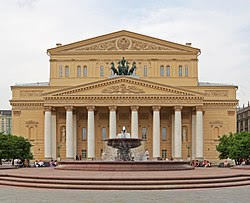 The Bolshoi Theatre
The Bolshoi TheatreThe formidable Norwegian soprano Lisa Davidsen, making her Metropolitan Opera debut in Tchaikovsky’s Queen of Spades, is right now New York’s most talked about opera singer. I caught the final performance in the run, on December 21 – and discovered myself mainly thinking about the Bolshoi Opera’s historic four-week New York season of 1975.
The Bolshoi was a throwback
to the days of ensemble opera – before airplanes. As of 1975 everything was still
sung in Russian. Everyone more or less stayed put in Moscow, sharing and
perpetuating inherited knowledge and tradition. I am referring not only to the
singers, but to the conductors, the chorus, and – most especially – to the orchestra.
Prior to that visit, I had
assumed that the pit acoustic of the Metropolitan Opera House was merely adequate.
The Met orchestra projected clearly. The sound was reasonably transparent. Balances
were often OK. But, even with Herbert von Karajan conducting Wagner, the too-big
house seemed incapable of conveying orchestral timbres as ravishing as, say,
the sound of the Vienna Philharmonic in its Staatsoper. And there was never
enough bass.
Astonishingly, the Bolshoi
orchestra projected a sonic kaleidoscope. There was plenty of bass. The winds
and brass quivered with color (in 1975 Russian orchestras still favored lots of
vibrato). The string choirs delivered coiled tonal wisps and torrential chordal
sheets.
Years later, Valery Gergiev’s
Mariinski Theater Orchestra, visiting the Met, was – again – a bigger, more
distinctive presence than the house band. It didn’t sound at all like the Bolshoi
Orchestra – its sonic signature was fuller, darker, less colorful, never
delicate. These were orchestras with personalities. And they participated in
the action as partners, not accompanists.
Pique Dame is an opera in which the orchestra is a full protagonist. It begins, in the pit, with signature Tchaikovsky: music of throbbing intensity, music that sounds hackneyed unless delivered with multi-hued intensity. Hearing the Met players launch Pique Dame, conducted by Vasily Petrenko, was dispiriting. The orchestra warmed up after that, and Petrenko made a distinctly positive impression. But not once over the course of three acts did I hear anything like a true duet between singers and instrumentalists.
When I got home I discovered that, miraculously, the Bolshoi Pique Dame – the one that came to New York – may be viewed in its entirety on youtube, filmed in live performance in Moscow in 1983.
If you want to hear what I am ranting about, go to 2:16:30: Tamara Milashkina singing Lisa’s act three aria, with Yuri Simonov (who made a strong impression in New York) conducting. The orchestra’s nuanced response to her initial introspection is empathetic. As her song gathers force, the sighing strings not only breathe, but feel with the singer. The final faint pizzicato is exquisitely calibrated. This kind of partnering is not produced by a mediating baton.
The Met once had such an orchestra, beginning in the 1880s — under Anton Seidl, Gustav Mahler, and Arturo Toscanini. I know, there are no recordings. (Lionel Mapleson’s turn-of-the-century cylinders capture other conductors.) But Seidl – the leading Wagner conductor of his generation – testified that New York had more first-rate orchestral musicians than any European city. And Mahler and Toscanini, chronic complainers both, never complained about the caliber of the Met orchestra (as Mahler complained about the New York Philharmonic). When we can at last audition the Met orchestra on surviving radio broadcasts, it’s still fundamentally an Italian band – the Toscanini imprint is indelible. This pit ensemble, gloriously maintained by Ettore Panizza (commanding the house’s Italian wing) and Artur Bodanzky (the German), was an absolute powderkeg — nothing like it any longer exists. (Panizza called the Met orchestra the equal of the Vienna Philharmonic – a claim that could not be made today.)
Here is the greatest Otello in recorded sound – conducted by Panizza on February 12, 1938, with Giovanni Martinelli, Lawrence Tibbett, and Elisabeth Rethberg. You can sample “Dio mi potevi” here. To observe that the orchestra “knows the opera” isn’t about the notes. Verdi is culturally kindred to these players: it’s in their blood.
Here is the greatest Siegfried in recorded sound – conducted by Bodanzky on January 30, 1937. Don’t expect the Vienna Philharmonic. This is eruptive, Italianate Wagner that sings. In Brunnhilde’s Awakening, the strings’ phased, surging ascent to “Heil dir, Sonne!”, capped by a hair-trigger detonation, is unique in my experience. (Start at 2:57:00 and strap yourself in.)
I once had occasion to share
this excerpt with my friend Alexander Toradze. Lexo is a distinguished product
of the Moscow Conservatory. He regularly attended the Bolshoi in the 1970s. Hearing
for the first time Kirsten Flagstad and Lauritz Melchior in their legendary Met
collaboration, he exclaimed: “What an orchestra!”
For more on Bodanzky at the Met, click here.
For more on Bodanzky and Panizza at the Met,
see my “Classical Music in America: A History of its Rise and Fall” (2005).
December 15, 2019
America’s Forbidden Composer: Take Two — Listening to Arthur Farwell
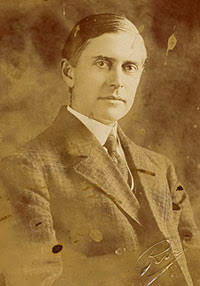
“America’s forbidden composer” is Arthur Farwell (1872-1952), leader of the “Indianists” movement in music. As I’ve discussed in a recent blog: politically, Farwell seems hopelessly incorrect today. But impressions of Farwell, insofar as they endure, are typically misimpressions. His significance is not merely historical. He composed some of the most original and compelling American piano, choral, and chamber music of the early twentieth century. Two new PostClassical Ensemble webcasts make it possible to actually listen to top-notch Farwell pieces in top-notch performances – and discover what is actually there.
Click here and you can audition:
—Pawnee Horses for 16-part a cappella chorus (1937)
–Two versions of Pawnee Horses for solo piano (1905)
–Two versions of Navajo War Dance No. 2 for solo piano
(1904)
—Three Indian Songs for baritone and piano (1908)
–The Hako String Quartet (1922)
Our webcasts also include, by
way of context:
–Music by Dvorak and Busoni
inspired by Native America
–Three formidable compositions
by the contemporary Native composer Jerod Impichchaachaaha’ Tate
–Two products of the South
Dakota Symphony’s visionary Lakota Music Project, one a vivid showcase for the
Native flutist Bryan Akipa, the other a remarkable collaboration between Akipa
and the composer Jeffrey Paul
All of this was heard at the Washington National Cathedral during PostClassical Ensemble’s “Native American Inspirations” festival two months ago. The festival’s principal revelation was Farwell’s Hako Quartet – a work never recorded (the world premiere recording, on Naxos, will be PCE-produced). As I’ve written in this space, its inspiration is a Great Plains ritual. Though it incorporates passages evoking a processional, or an owl, or a lightning storm, it does not chart a programmatic narrative. Rather, it is a 20-minute sonata-form that documents the composer’s enthralled subjective response to a gripping Native American ritual. It conveys throughout a primal tingle. It mounts to climaxes of exaltation rare in the American chamber-music literature. It bears intense witness to elemental magic and mystery.
Our webcast includes commentary
by the South Dakota Symphony’s music director, Delta David Gier, who coached
the gripping Lakota String Quartet performance in DC. Gier calls the Hako “a salute from one culture to
another,” part of a centuries-old tradition of cultural fusion in the concert
hall. He says that Farwell is “someone who needs to be rediscovered.” At the
same time, Gier does not envision presenting the Hako on Indian reservations within his Lakota Music Project. The Native
American musicians with whom he regularly – and remarkably – interacts are, he
explains, “not interested in the white man’s take on their culture.”
As I say in our webcast colloquy, this decision makes me “uncomfortable.” “I’m very protective of Farwell because of the degree to which is music is forbidden,” I respond. “With the greatest respect and admiration for you, and what you’ve achieved in South Dakota, I think I disagree. Because if you take that attitude, I fear you’re feeding a widespread and ill-informed prejudice. It’s as if he were a forbidden composer in [Maoist] China or the Soviet Union. I know: you perform this music, and you’re in deep trouble.” (In DC, the Museum of the American Indian wanted no part of our festival; a Museum representative said Farwell lacked “authenticity.” On twitter, PostClassical Ensemble was attacked by a torrent of writers none of whom had ever heard a note of Farwell’s music.)
You can listen to the entire exchange and ask yourself who is being more “disrespected” when the Hako is forbidden – Arthur Farwell or Native America.
Another highlight of the
webcasts is a unique presentation by William Sharp – a supreme American concert
singer who regularly partners PCE. Bill was assigned Farwell’s Three Indian Songs – music which he approached with some trepidation. As he recounts,
he discovered himself so consumed with this assignment that he investigated the
pertinent legends, auditioned historic wax cylinders of Indian chant, and
conferred with the Lakota singer/drummer Emmanuel Black Bear. You can hear Bill
describe it all – and caution against “thoughtless knee-jerk” condemnations of “cultural
appropriation.”
The deeper Bill immersed
himself in Farwell’s world and its sources, the more galvanized he became; he acquired
a mission. As I remark in our webcast, his response seemed a microcosm of Farwell’s
journey. Farwell is a composer who plainly felt compelled to become an “Indianist.”
As Bill McGlaughlin, our inimitable host, puts it: “It’s how music is
transmitted. It’s what musicians do.”
To finally frame the cultural
appropriation debate, we listened to what was once by far the best-known
Indianist concert song: Charles Wakefield Cadman’s “From the Land of the Sky
Blue Water” (1909). I would call this song a specimen of tuneful kitsch. That
is: we sampled a full spectrum of “appropriation.” In their own time, Farwell and
Cadman were antipodes. Farwell passed on including Cadman’s songs in his Wa-Wan
Press publications. Cadman, in turn, viewed Farwell as a kind of fanatic, out
of touch with practicalities. As I have previously
written: Cadman’s once-famous song is as remote from Farwell’s Pawnee Horses as a balalaika orchestra playing
“Dark Eyes” is remote from Stravinsky’s Les
noces. Beware of facile generalizations about the Indianists.
What to make of Cadman’s song today? Is it “cultural misappropriation”? Is it “disrespectful”? On our webcast, David Gier answers “Yes and no.” Bill McGlaughlin says: “For me, it’s a period piece. I’m not offended by it – I just don’t want to hear it again.” Bill proceeds to compare Cadman unfavorably to Sigmund Romberg and Victor Herbert – “period composers” of higher ability.
For me, as for Bill, the pertinent
criterion is aesthetic, not moral. If “From the Land of the Sky Blue Water” today
seems ephemeral, it’s partly because, unlike Farwell (or Dvorak or Busoni), Cadman
was not smitten by the primal. He did not ride a tidal ardor for Native
America. He merely discovered something useful.
I remark in closing: “How I
wish that this conversation were more pervasive. Instead, it’s usually just
silenced. It was hard as hell to get this conversation started in DC because so
many people refused to take part. That there are actually people who refuse to
listen to the music of Arthur Farwell – this pains me.”
For more on Arthur Farwell and cultural appropriation, click here. To read a blog about Harry Burleigh and cultural appropriation, click here.
NATIVE AMERICAN INSPIRATIONS: LISTENING GUIDE
PROGRAM ONE
Part One:
00:00: Farwell: Pawnee
Horses for a cappella chorus, performed by the University of Texas Chamber
Singers conducted by James Morrow
2:00: Introducing Arthur Farwell
7:50: Farwell: Pawnee
Horses for solo piano, performed by Benjamin Pasternack, then by Emanuele
Arciuli
14:23: Farwell: Pawnee
Horses for a cappella chorus (reprise)
19:23: Farwell: Navajo
War Dance No. 2 performed by Emanuele Arciuli
25:40: William Sharp introduces Three Indian Songs by Arthur Farwell and discusses “cultural
appropriation”
32:40: Farwell’s “Song of the Deathless Voice” introduced
and performed (35:40) by William Sharp with pianist Emanuele Arciuli
38:30: Farwell’s “Inketunga’s Thunder Song” introduced and
performed (39:40) by William Sharp with pianist Emanuele Arciuli
42:16: Farwell’s “Old Man’s Love Song” introduced by William
Sharp
44:18: A pertinent wax cylinder recording from the 1890s
50:39: Farwell’s “Old Man’s Love Song” performed by William
Sharp and Emanuele Arciuli
Part Two:
6:24: South Dakota Symphony Music Director Delta David Gier
describes the Lakota Music Project
10:20: Farwell: Hako
String Quartet excerpt 1, performed by the Lakota String Quartet
15:16: Farwell: Hako
String Quartet excerpt 2
32:59: Larghetto from Dvorak’s Violin Sonata (Netanel
Draiblate and Emanuele Arciuli) preceded by the pertinent Longfellow passage
read by William Sharp
45:09: Busoni Indian
Diary No. 1 performed by Emanuele Arciuli
59:33: Cadman: “From the Land of the Sky Blue Waters”
1:10:19: Farwell: Navajo
War Dance No. 2 performed by Benjamin Pasternack
PROGRAM TWO
Part One:
00:00: “Resolution” by Jerod Tate, sung by William Sharp
with PostClassical Ensemble led by Angel Gil-Ordonez
12:10: Shakamaxon
(movement one) by Jerod Tate, performed by PostClassical Ensemble led by Angel
Gil-Ordonez
27:29: Shakamaxon
(movement two) by Jerod Tate
42:26: Victory Songs
(excerpt) by Jerod Tate, performed by baritone Stephen Bryant and the South Dakota
Symphony led by Delta David Gier
Part Two:
10:15: Wind on Clear
Lake by Jeffrey Paul, performed by Bryan Akipa and members of the South
Dakota Symphony led by Delta David Gier
22:13: Bryan Akipa describes composing Meadowlark
26:11: Meadowlark by
Bryan Akipa, performed by Akipa and members of the South Dakota Symphony
41:04: “Prologue” and “Hiawatha’s Wooing” from the Hiawatha Melodrama, composed by Michael
Beckerman and Joseph Horowitz, with Kevin Deas (narrator) and PostClassical
Ensemble led by Angel Gil-Ordonez
53:30: “The Hunting of Pau-Puk Keewis” and “Epilogue:
Hiawatha’s Departure” from the Hiawatha
Melodrama
November 9, 2019
Porgy — Take Four
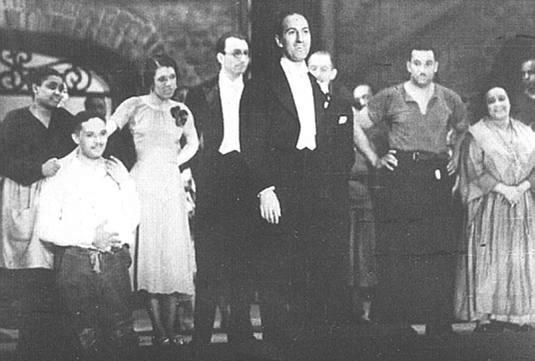 Curtain call for “Porgy and Bess” with Rouben Mamoulian in glasses
Curtain call for “Porgy and Bess” with Rouben Mamoulian in glasses The latest installment of Conrad L. Osborne’s indispensable opera blog takes stock of Porgy and Bess and the Met’s acclaimed new production. It also graciously plugs my own recent series of Porgy blogs in this space, my American Scholar review of the Met Porgy, and my book (“On My Way” – the Untold Story of Rouben Mamoulian, George Gershwin, and “Porgy and Bess”) about this opera’s complex and illuminating genesis.
To my ears, Porgy and Bess is the highest creative
achievement in American classical music. Osborne is not convinced. A crucial sticking point is the anomaly my
book exposes: it is an opera with two endings. The first is that of DuBose Heyward,
who wrote Porgy the novel: Bess
deserts Porgy; Porgy collapses (“Oh Bess, oh where’s my Bess?”). The second was
invented by the opera’s first director, Rouben Mamoulian: Porgy lifts himself
up and declares himself on his way “to a heav’nly land.”
Is this double ending, not
created but creatively absorbed by Gershwin, a unique inspiration? Or is it an
unwanted confusion imposed by an ingenious but meddlesome stage director then
at the peak of his fame and influence? (Rouben Mamoulian received equal billing
with George Gershwin: think about that.)
Osborne finds the Mamouian ending unconvincing, tacked on – “like a rather perfunctory, conventional music-comedy happy ending.” I believe in the Mamoulian ending. Like Porgy’s, this is an act of faith: I have yet to see it adequately realized on stage.
That Mamoulian should have changed Heyward’s ending – a process explored in detail in my book – was merely predictable. He rigidly espoused uplift, and Heyward’s ending — “a face that sagged wearily, and the eyes of age lit only by a faint reminiscent glow from suns and moons that had looked into them, and had already dropped down the west” – is lyrically yet unrelievedly bleak. If Mamoulian had merely picked Porgy up, the new ending would be risible. But Mamoulian did a lot more than that. He fundamentally reconceived Porgy’s character as prepossessing, actually heroic. He fundamentally reconceived Porgy’s story as an odyssey of personal realization: a cripple made whole. And he furnished a brilliant linchpin for Porgy’s regeneration, the opera’s most telling line: “Bring my goat!”
As I have argued, two
necessary ingredients to bring this line off are missing in the Met production,
directed by James Robinson with Eric Owens as Porgy. They are also not to be
found in the DVD of the San Francisco Opera production directed by Francesca Zambello
with Owens as Porgy again.
The first ingredient is the declaration “Bring my goat!” itself — or something sufficiently like it. There is no goat in either production. That is: Porgy is not severely crippled. Rather than ambulating on a goat-cart because his legs are limp, he walks on crutches. For all that we can glean, he could have gone to that picnic after all. His crucial self-assessment – that when God made cripples he made them to be lonely – no longer tells. He is by no means a man for whom winning a woman seems self-evidently inconceivable. So his story of unlikely self-realization, a central tread of the opera, is greatly diminished.
The second necessary
ingredient, arising from the first, is that Porgy’s resolve to pick himself up
must become a moment of crisis and surprise. We must not know – he must not
know — that he can make it. If we do, Mamoulian’s ending is truly “tacked on.”
A further point: Gershwin makes the most of Mamoulian’s ending. He not only provides a great tune; he conceives a musical master-stroke to seal Porgy’s odyssey. We know that his models for Porgy and Bess included Wagner’s Die Meistersinger, Bizet’s Carmen, and Berg’s Wozzeck. An important 2007 article by Christopher Reynolds shows, for instance, that Gershwin’s pertinent study of Wozzeck was far from casual. In my book, I propose that Gershwin also had a good look at Wagner’s Gotterdammerung. When Siegfried dies, Wagner composes a singular symphonic dirge. Its power derives from its narrative trajectory; rather than merely memorializing Siegfried, the orchestra here retells a family history beginning with the love and pathetic fate of Siegfried’s parents, Siegmund and Sieglinde. At the close of Porgy and Bess, Gershwin has his orchestra recapitulate Porgy’s story. Not on stage, but in the pit, strands of “I got plenty o’ nuttin’,” “What you want with Bess?,” and “Bess you is my woman now” (among other tunes) are tellingly reprised. It should become one of the opera’s most stirring events, sealing Porgy’s trajectory. Here again the Met production disappoints. This orchestral peroration needs more weight and balance than it receives under David Robertson’s baton. To my ears, it is too brisk (Gershwin’s final instruction is “Grandioso” and fortissimo). And the motives do not get equal weight, with the trumpet’s “What you want with Bess?” in the foreground and the strings’ “plenty o’nuttin” a secondary strand.
Osborne, in his blog, suggests that essentially Porgy and Bess may be “a remarkable—probably the most remarkable—example of music theatre in the tradition of American stage realism, certainly transcending the model of the musical, though quite strongly influenced by it.” Perhaps this was Gershwin’s drift, however subliminally. If so, he should never have insisted on Rouben Mamoulian directing Porgy and Bess. From Mamoulian’s direction of the play-with-music Porgy in 1927, Gershwin would not only have known the Mamoulianized Porgy and Mamoulianized ending, both of which originate with Mamoulian’s draconian revisions of the Porgy script. He would have also known that Mamoulian, shunning verisimilitude, was a master choreographer of elaborate tableaux. Most notably, Mamoulian in 1927 turned Robbins’ funeral into something like a stylized voodoo rite with towering, precisely calibrated shadows. And in the hurricane scene he unforgettably grouped a huddled mass of terrified human beings into a triangular wedge. Both these effects would be recapitulated in the opera eight years later, as would be a daybreak “symphony of noises” with choreographed sweeping, snoring, and pounding.
Heyward’s Catfish Row had been a cultural anthropological reconstruction by a native Southerner. It is no wonder that he advised Gershwin to hire a different director (he proposed the young John Houseman). In sticking with Mamoulian, Gershwin opted for an anti-realistic staging — the one with the “miracle” ending. Whatever the wisdom of this decision, it is a crucial and conscious component of the opera’s gestation.
(Adducing a realistic Porgy and Bess aesthetic, Osborne adds that “Kurt Weill’s Street Scene, also a tragedy, is the closest comparison I can think of.” Interestingly, Mamoulian was Weill’s first choice for Street Scene — which Mamoulian would doubtless have Mamoulianized. Weill subsequently succeeded in landing Mamoulian for Lost in the Stars — with controversial results.)
P.S. – I have not attempted to share the characteristic richness of detail and insight in Conrad Osborne’s posting. Read it yourself (or read my Wall Street Journal review of his seminal mega-book Opera as Opera). Here’s an e.g.:
“There is no way
. . . that one can take in the words, music, and dramatic functions of any of
the more prominent characters [of Porgy
and Bess] and label them stereotypes. They’re fleshed-out, living people. Nonetheless, they have been
vulnerable to attack from the not-good-for-African-Americans p.o.v., which from
its more extreme angles objects to the very presence of unpleasant or even
morally conflicted characters. It’s tantamount to
saying you can’t represent black
people, disadvantaged people, poor people, unless it’s to ennoble
them, as in a patriotic pageant or on a valorizing mural. That’s not a valid
artistic principle.”
November 4, 2019
America’s Forbidden Composer
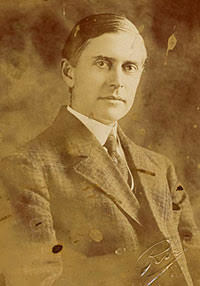
— I —
“Arthur Farwell is probably the most neglected composer in our history. . . . At the turn of the century no one wrote music with greater seriousness of purpose or fought harder for American music. . . . He was an intellectual and spiritual giant.”
This assessment, by the late
composer/critic A. Walter Kramer in 1973, rings ever louder today; Farwell has
been deemed untouchable. Hounded by the watchdogs
of “cultural appropriation,” he has fallen prey to dictates of political
rectitude, a victim of our escalating culture wars.
He was (among many other
things) the leader of the “Indianists” movement in American music – a huge and yet
forgotten swath of cultural history, amassing many hundreds of operas,
symphonies, chamber works, and songs until petering out in the 1930s. I first
discovered Arthur Farwell via a New World Records “Indianists” LP about twenty
years ago. The Farwell pieces on that recording weren’t very good, but they
were original. I was curious to know more about a composer who, inspired by
Dvorak, thought Americans would one day become sufficiently enlightened to
embrace Native America as an essential component of our national identity. I
soon discovered, in score, Farwell compositions far more challenging both for
performer and listener – forgotten music, once esteemed, and yet never
recorded. Ever since, I’ve seized every opportunity to present it in concert.
Not long after my Farwell
discovery, I encountered a prominent Native-American ethnomusicologist who told
me that she did not listen to Arthur Farwell’s music as a matter of principle.
This is the kind of challenge Farwell poses.
PostClassical Ensemble – the “experimental” DC chamber orchestra I co-founded in 2003 with the remarkable Spanish conductor Angel Gil-Ordonez – is dedicated to curating the musical past. As readers of this blog know, we champion composers whose time will come. Silvestre Revueltas, Bernard Herrmann, Lou Harrison are the top of our list. Whether Farwell’s time will come is another question – it will, alas, depend on political, not musical winds of change.
The 2014 PCE Naxos CD “Dvorak and America” was a start. It includes three top-drawer Farwell cameos in terrific performances: the piano pieces Pawnee Horses and Navajo War Dance No. 2 played by Benjamin Pasternack, and a 16-part a cappella version of Pawnee Horses sung (in Navajo) by the University of Texas Chamber Singers under James Morrow – one of half a dozen distinguished choral conductors who I’ve observed discovering Farwell with incredulity. You can hear the UT performance by clicking here and scrolling down.
A week ago, PCE produced a
week-long festival, “Native American Inspirations,” surveying 125 years of
music inspired by Native America. That is – we linked Dvorak, Farwell, and the
Indianists to contemporary composers, Native and non-Native, who mine Native
American songs and ceremony. In a few weeks’ time, that festival will generate
a four-hour “PostClassical” podcast. After that will come a PCE-produced
Farwell release, on Naxos, with world premiere recordings.
The DC festival, headquartered at the Washington National Cathedral, provoked divergent reviews from Anne Midgette in the Washington Post and Sudip Bose in The American Scholar. Midgette gave short shrift to Farwell; she wanted to hear more music composed by Native Americans. Her review was buttressed by a flood of supportive tweets condemning Farwell as an appropriator. Bose mounted a considered rebuttal (see below).
The festival itself included
a Saturday night public conversation, at the Center for Contemporary Political
Art, that attempted to unpack the controversy clouding Farwell and his
movement. I will return to that event below. But first: the music.
–II–
Charles Martin Loeffler called Arthur Farwell’s Pawnee Horses for solo piano (1905) “the best composition yet written by an American.” As Loeffler was for a time the most highly regarded American composer, a schooled aristocratic musical personality, a man who also grasped the importance of George Gershwin when others dismissed Gershwin as a gifted dilettante, his opinion means something. The piece itself, setting an Omaha song, is not even two minutes long. A downward cascading chant is framed by galloping figurations. The pianistic lay-out, with multiple hand-crossings, is idiomatic and ingenious. Most memorably, Farwell deploys harmony and texture to create a fragrant aura of mystery; at the close, the gallop dissipates in the treble. Considered as a musical composition, without reference to source or inspiration, Pawnee Horses is indisputably top-notch. In 1937, Farwell created a second version for a cappella chorus; the closing ascent touches a pianissimo high C. Musically considered, Pawnee Horses is a choral tour de force. Again: you can access this piece here.
Another early Farwell piano solo – Navajo War Dance No. 2 – was championed by John Kirkpatrick. He is the pianist who premiered Charles Ives’s Concord Sonata. This 1904 Farwell miniature is notably astringent, rhythmically and harmonically complex. It is also hard to play. It more resembles Bartok than any other American composition I know. But Farwell could not possibly have known pertinent Bartok keyboard music in 1904.
In the hidden world of Arthur
Farwell, the two piano pieces I have just mentioned are relatively known. But
his biggest Indianist composition, the Hako
String Quartet of 1923, is certainly not. I had occasion to present it with
student performers at the New England Conservatory in 1999. The late David MacAllester,
an eminent authority on Native American music, was at hand to react. McAllister
was greatly impressed by the Hako
Quartet.
One of the challenges of presenting Farwell in concert is enlisting Native American participants. For our DC festival, I unsuccessfully attempted to engage Native American scholars and musicians from as far away as Texas, New Mexico, and California. My greatest disappointment was the Smithsonian Museum of the American Indian, which declined to partner the festival even though it presented in concert the South Dakota Symphony’s Lakota Music Project, brought to DC at the invitation of PostClassical Ensemble. A staff member explained that Farwell lacked “authenticity.” But the Hako claims no authenticity. Though its inspiration is a Great Plains ritual celebrating a symbolic union of Father and Son, though it incorporates passages evoking a processional, or an owl, or a lighting storm, it does not chart a programmatic narrative. Rather, it is a 20-minute sonata-form that documents the composer’s enthralled subjective response to a gripping Native American ritual. At our festival, a sensational performance of the Hako by the Dakota String Quartet (comprising the principal strings of the South Dakota Symphony) ignited a thunderous ovation. This is a work that skillfully builds to an enraptured close, marked “with breadth and exaltation.” It is Arthur Farwell’s rapture that is here “authentic.”
Sudip Bose did not attend our Monday night concert, with the Hako. In Anne Midgette’s view, the Hako “did little with its musical ideas.” A third critic, Emily Wright for Strings Magazine, was more sympathetic but could not resist terming Farwell “perhaps naive” — meaning what? Unlike Bose’s, in The American Scholar, her summary of the Farwell story was vague and inaccurate. Her mild approbation was unconsciously patronizing.
Other Farwell compositions
are differently conceived. They more resemble transcriptions or adaptations of
Native American song. Pawnee Horses
attempts to evoke the complexity of Indian rhythms and tunes. But it would be
glib to infer that he here aspires to “authenticity.”
So what was Farwell trying to
do? He believed it was a democratic obligation of Americans of European descent
to try to understand the indigenous Americans they displaced and oppressed – to
preserve something of their civilization; to find a path toward reconciliation.
His Indianist compositions attempt to mediate between Native American ritual
and the Western concert tradition. Like Bartok in Transylvania, like Stravinsky
in rural Russia, he endeavored to fashion a concert idiom that would paradoxically
project the integrity of unvarnished vernacular dance and song. He aspired to
capture specific musical characteristics – but also something additional,
something ineffable and elemental, “religious and legendary.” He called it – a
phrase belonging to another time and place – “race spirit.”
As a young man, Farwell visited
with Indians on Lake Superior. He hunted with Indian guides. He had out-of-body
experiences. Later, in the Southwest, he collaborated with the charismatic
Charles Lummis, a pioneer ethnographer. For Lummis, Farwell transcribed hundreds
of Indian and Hispanic melodies, using either a phonograph or local Indian
singers. Even so, our present-day
criterion of “authenticity” is a later construct, unknown in Farwell’s day. If
he was subject to criticism during his lifetime, it was for being naïve and
irrelevant, not disrespectful or false. The music historian Beth Levy – a rare
contemporary student of the Indianists movement in music – pithily summarizes
that Farwell embodies a state of tension intermingling “a scientific emphasis
on anthropological fact” with “a subjective identification bordering on
rapture.”
Other writings perpetuate misleading assumptions. John Troutman’s Indian Blues (2009), a valuable treatment of “American Indians and the Politics of Music, 1879-1934,” groups Farwell with other Indianists “dedicated to the production of Indian themes palatable to non-Indian ears . . . they seemed in the end to share much more in common with the imagery found in Tin Pan Alley numbers than with the performances as originally observed and recorded by the ethnologists.” This verdict may fit Charles Wakefield Cadman, also mentioned by Troutman. But Farwell cannot credibly be dismissed in the same breath; Troutman has not done the homework. Neither does the distinguished Native-American ethnomusicologist Tara Browner, in a 1997 American Music article, undertake any concerted effort to assess the varied style and caliber of Farwell’s Indianist output. Though she prefers him to Edward MacDowell (who lacked Farwell’s passion for ethnology), Brower expresses regret that Farwell failed to “seek permission” to “incorporate” Native American music in his own. But in 1905, when Pawnee Horses was conceived, no composer, writer, or painter adapting Native American music and ritual would have thought to do that. The only present-day Native-American Farwell authority of whom I am aware is the pianist Lisa Cheryl Thomas, who admires and performs him.
Here is Sudip Bose, in his American Scholar review:
“To be sure, we can look back at Farwell’s interactions with Native American cultures, and find him lacking in certain areas. . . . Beth Levy writes that the composer’s attitudes toward Native Americans ‘never completely slough[ed] off their skin of exoticism.’ . . . Yet it cannot be denied that Farwell’s reverence for Native American music was genuine. . . . It’s a tricky thing—trying to come to terms with Farwell in our time. His perceived flaws provide detractors with enough justification to reject him out of hand. To them, it doesn’t matter what his music sounds like, or what part it played in the evolution of classical music in the United States. To them, Farwell is simply a white man who made a living at the expense of marginalized peoples. This, I believe, not only misrepresents the composer and his intentions, but it also uses the politics of our current moment to form loose judgments about a very distant time. . . . I would also like to assert that Farwell, despite his keenest ethnographic instincts, was not an ethnographer. His principal aim was not to document Native music, and certainly not to compose it. Rather, he was writing classical music—an anti-modernist classical music, rooted in diatonic harmony and sonata form, that he felt best represented America.”
–III–
Classical music lives in the
concert hall and the opera house. But classical composers – many of them –
crave the primal. It impels them to compose, no questions asked. Bartok in
rural Transylvania, Falla in the gypsy caves of Granada were galvanized by
elemental songs and dances they proceeded to diligently research. Harry
Burleigh – a frequent topic of this blog – was impelled to turn the sorrow
songs once sung by his grandfather into tuxedoed concert songs. These
transformations will always be genuinely controversial. Flamenco purists find El amor brujo denatured. Zora Neale
Hurston found concert spirituals sanitized. But these are aesthetic, not moral
judgments.
At our Saturday night conclave, pondering “cultural appropriation,” an audience member suggested a bell curve, with respectful appropriation at one end and cultural theft at the other. But an aesthetic bell curve makes more sense to me. When appropriation makes us cringe, it becomes kitsch – dictionary-defined as “in poor taste because of excessive garishness or sentimentality.” The most popular Indianist song was “From the Land of the Sky-Blue Waters,” composed by Charles Wakefield Cadman in 1909. I would call that a specimen of tuneful kitsch. Though Cadman adapted an actual Native American tune, the relationship to source material is merely expedient, self-evidently casual. Cadman’s song is as remote from Pawnee Horses as a balalaika orchestra playing “Dark Eyes” is remote from Stravinsky’s Les noces.
Farwell explicitly declared himself an enemy of kitsch. He did not always succeed. To my ears, his Navajo War Dance No. 1 in its piano and choral versions – pieces on that New World LP I encountered decades ago – are “in poor taste.” They sound tacky, superficially exotic. My daughter would call them “cheesy.” Removed from the context of Farwell’s better efforts, they suggest a nonchalant submission to cliche.
In
any event: Farwell is an essential component of the American musical odyssey.
As I have too many times had occasion to observe, the appropriation critique
suppresses historical inquiry. It also cancels opportunities to engage with artworks
of high consequence. Charles Ives’s Second Symphony is one of the supreme
American achievements in symphonic music. Its Civil War finale quotes “Old
Black Joe,” a blackface minstrel song by Stephen Foster, by way of expressing
sympathy for the slave. When there are students in the classroom who cannot get
past that, it is their loss.
Even
worse is the chilling effect of the war cry. If Farwell is today off limits, it
is partly because of fear – of castigation by a neighbor. I know because I have
seen it.
Opinions
will differ about the caliber of his music. But it must be heard.
Stay tuned for a December blog linking to “PostClassical” webcasts featuring the “Hako” Quartet and five more Farwell piano and vocal compositions recorded in live performance at our DC festival.
October 20, 2019
Solomon Volkov on Stalin and Shostakovich
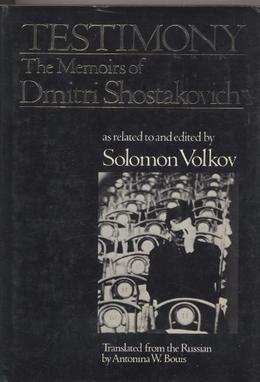
Of Joseph Stalin the culture-czar, Solomon Volkov comments:
“People underestimate the level
of control that Stalin maintained. I once tried to count the number of people in
the arts that Stalin controlled personally – listened to their music and read
their books. It was close to one thousand. This was Stalin’s habit. So Shostakovich
knew very well he was under the constant surveillance of the most powerful
person in the country. Stalin’s involvement in the world of culture was
extraordinary. It was something unprecedented. There is evidence that he read
every day 300 to 400 pages of fiction and non-fiction.
“When describing Stalin I use two words. He was an ‘evil genius’. People writing about Stalin sometimes judge him like a dean of the faculty or something like that. They don’t understand that he was extraordinarily gifted – in terms of things like memory and energy. People like that are born maybe once in a century. To be sure, he was a totally evil person. No one in their right mind would argue with that. But, for example, he would never raise his voice, especially when talking to artists. He was always very polite. And he was often more informed than they were. The famous Stalin Prize committee would submit works for his approval. ‘Did you actually read this book?’ he would ask the committee. And they knew that before Stalin you couldn’t lie. ‘No, comrade Stalin, I did not read this book.’ And Stalin might answer: ‘And I unfortunately did.’ He considered himself a kind of father figure. A father would punish his child – and then he might reward him.”
As author of Testimony: The Memoirs of Dmitri Shostakovich, Volkov speaks with special authority. (Never mind the “Shostakovich Wars” – Testimony is a record of Shostakovich as understood by Volkov. Others have a different picture. Human beings have no fixed identity.) The Volkov commentary I here quote derives from our latest “PostClassical” podcast: “Shostakovich and the Cold War.” You can audition the entire three hours of music and conversation here.
Bill McGlaughlin asked Solomon Volkov to describe his first meeting with Dmitri Shostakovich.
“I started to write about music
at a very early age. I was fifteen. I moved to Leningrad to study there, and I was
still a pupil when I went to the premiere of Shostakovich’s Eighth String Quartet.
I had already published several pieces in Riga and Leningrad. After listening
to the Eighth Quartet I was extremely impressed. I went to the local newspaper
and suggested that I write a review. The accepted it. And it happened that my
small piece was the first review of this very important Shostakovich piece that
appeared in print.
“Shostakovich, to his credit or not, read every review. He was never this type of genius who says ‘I am not interested.’ He never pretended to be. So sometime later I went to a Shostakovich concert in Leningrad and somebody introduced me to him. And he remembered. ‘Oh yes, I read your review.’ He said a few nice words. I of course was elated. And that was the start of our relationship.
“I wouldn’t dare to record
him. He was mortally afraid of a microphone. When he was not talking in his
official capacity he could be very eloquent. But the moment he was obliged to
say something official he was a different person.”
And Shostakovich was a different person, as well, to President John F. Kennedy, Nicolas Nabokov, and other practitioners of the cultural Cold War – the first topic of our podcast. It begins with the voice of JFK, denying that the Soviet Union could possibly produce great art. Commensurately, Shostakovich was long denigrated in the West as a Soviet stooge. Around the time Leonard Bernstein spoke up for Shostakovich in, 1966, the culture winds began to change. Testimony, published in 1979, marked a turning point; Shostakovich was never again dismissed as a purported tool of the Communist Party. I asked Volkov if Shostakovich’s “messages in a bottle” – the dissident subtexts we now discern – were acknowledged in Soviet Russia. He said: “In the West they were not
interested, and in the Soviet Union they were afraid.”
A second topic of our podcast is music and World War II – we compare Stravinsky’s Symphony in Three Movements (1945), Prokofiev’s Seventh Piano Sonata (1942), and Shostakovich’s Piano Trio No. 2 (1944). I’ve previously written a lot about Stravinsky’s musical picture of World War II, a California product inspired by newsreels of goose-stepping soldiers and falling bombs. Prokofiev, too, records the tumult of battle – as does the amazing live performance by Alexander Toradze (from a PostClassical Ensemble concert of 2017) that we audition. Shostakovich’s wartime response in his Second Trio is, by comparison, markedly interior. It does not document the war; it extrapolates a message for humanity.
How did Shostakovich so
manage to transcend the personal – to “bear witness”? Angel Gil-Ordonez, on our
podcast, pertinently remarks: “Shostakovich is always on the side of those who
suffer. This is what touches us.”
LISTENING GUIDE:
PART ONE:
00:17 – JFK speaking about
the “place of the artist” in “free societies” – and denying the possibility of
distinguished Soviet art
10:15 – Nicolas Nabokov, the
source of Kennedy’s doctrine, denounces Shostakovich
11:18 – Shostakovich: Prelude
and Fugue in D minor (Benjamin Pasternack, piano)
26:15 – Leonard Bernstein
speaks up for Shostakovich (1966)
27:33 – How Solomon Volkov
met Shostakovich; the String Quartet No. 8
29:00—Volkov on Stalin as
culture-czar
39:07 – Shostakovich/Barshai:
String Symphony (PCE conducted by Angel Gil-Ordonez)
PART TWO:
00:00 – Waltz from The New Babylon, Shostakovich’s first
film score (PCE/Gil-Ordonez)
3:44 – Volkov on Shostakovich
and film
9:07 – The New Babylon: finale (PCE/Gil-Ordonez)
18:00 – JFK notwithstanding:
propaganda as high art — The New Babylon
20:30 – Volkov on Stalin and
film; “he read 300 to 400 pages a day”
24:00 – Musical responses to
WW II: Stravinsky vs. Prokofiev vs. Shostakovich
31:45 – Prokofiev Piano Sonata No. 7: finale (Alexander Toradze, as filmed/recorded by Behrouz Jamali for PCE)
44:00 – Shostakovich “bears
witness” to his times
PART THREE
00:00 – Shostakovich Trio No. 2 (Netanel Draiblate/Benjamin Capps/Alexander Shtarkman, as filmed/recorded by Behrouz Jamali for PCE)
30:00 – Volkov on
Shostakovich and Jewish music
October 13, 2019
Is Porgy a “Stereotype”? — Take Three
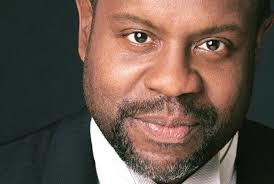 Kevin Deas
Kevin DeasKevin Deas, the exceptional bass-baritone who is the anonymous “Porgy” of my previous blog, has written to me at greater length about singing the part – and the importance of the view “from below.” He says:
“Being on my knees for my first staged Porgy was revelatory. Not only was it the first time that I’d sung the complete role, it was that perspective that was, in particular, very profound.
“I’d sung the concert version (comfortably erect) 10s of times. I didn’t fully appreciate the character. Now when I sing extended concert versions, I try to incorporate that perspective. I often ask to sing the duet sitting. Bess standing, passionate, baffled, next to the cripple (not someone merely indisposed). That positioning alone portends the unlikely success of this pairing. When she kneels towards the end (as in the production I was in) she acquiesces and inhabits his low-lying, sweaty (probably smelly) existence. It makes the desperate nature of their circumstance more sympathetic.
“Being on his knees also makes Porgy’s plight that much more compelling for the audience. The interpretation necessarily becomes more nuanced.
“As the performance starts, the daunting prospect of being on one’s knees for nearly three hours puts one in a specific emotional space. Hearing the beauty of Gershwin’s musical adoration (as the orchestra plays the ‘Porgy motif’) as I enter on the cart gives me comfort.
“Before I discovered inline knee braces, with gel padding, I could peel a layer of skin off of my knees from the constant burn after an extended tour. The most difficult scene was kneeing my way across the stage to bring down Crown.”
Kevin – with whom I have been privileged to perform the spirituals of Harry Burleigh for a dozen years – is the most mellifluous Porgy I know. How I wish he had an opportunity to record it. You can see and hear him sing “I got plenty o’ nuttin’” and “Bess you is my woman” (with Angela Brown) in concert (in Moscow) here: https://www.youtube.com/watch?v=GBRd_oHxFSc
It occurs to me to add that no opera of comparable stature (with the possible exception of Wagner’s Siegfried) has been so disserved in performance.
Last Spring, teaching a graduate seminar on music and race at SUNY Purchase, I spent a full month exploring Porgy and Bess with my students. Every one of them preferred DuBose Heyward’s novel to Gershwin’s opera. The reason is that they were new to the opera (except for some songs) – and there does not exist an adequate recording or film. We made do with Simon Rattle’s studio-bound Porgy and Bess and the disappointing San Francisco Opera DVD. There are recordings with various points of excellence, but none in which the casting, conducting, playing, and trims (this is an opera that must be abridged) add up. I could not convey to my students a full, true impression.
PS — Another memorable email, from the prominent American historian Allen Guelzo, in response to my American Scholar review of Porgy at the Met: “In my mind, I step back and see Gershwin against what Thomson and Copland were writing then, and suddenly it comes to life, and makes them look like over-dressed primas.”
October 11, 2019
Is Porgy a “Stereotype”? — Take Two
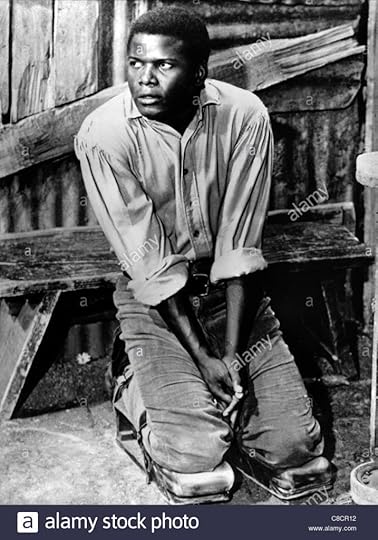 Sidney Poitier as Porgy
Sidney Poitier as PorgyOf the interesting emails I received in response to my American Scholar review of Porgy and Bess, the most informative was from a singer with considerable experience doing Porgy on stage. He wrote:
“As challenging as it was for me to
sing most of Porgy on a cart (the rest of the time I was on my knees), there is
no substitute for singing and viewing the world from that perspective.”
Gershwin intended Porgy to be pulled by a goat while sitting on a cart. He is a man who cannot stand up. Today Porgy is typically ambulatory on crutches: mobilized. I now realize this is one of the reasons that Eric Owens’s portrayal, at the Met, “starts too strong.” It is because he is erect.
Early on, Porgy sings: ““When Gawd make cripple, He mean him to be lonely. He got to trabble dat lonesome road.” This crucial self-observation only really registers when Porgy “views the world” from below. And the goat reinforces his distance from normal human company.
Also — as John Mauceri just pointed out in another email to me — if Porgy can walk on crutches, he can go to that picnic.
Additionally, re-reading my review, I wish I had been more explicit about the regrettable impact of Sidney Poitier’s performance in the 1959 Otto Preminger film version of Gershwin’s magnificent opera. Poitier is so manifestly uncomfortable in this role that his portrayal reads as a critique. However subliminally, we are made to believe that Gershwin has created an objectionable “stereotype.” So far as I can ascertain, this is a claim mainly originating in the fifties: long after the opera’s premiere and initial reception.
It was my privilege to speak with Poitier on the phone when I wrote “On My Way” – The Untold Story of Rouben Mamoulian, George Gershwin, and “Porgy and Bess.” He was perfectly candid. He never sought to play Porgy. Rather, Lillian Schary Small, a sometime associate of Poitier’s agent Martin Baum, sought and acquired it for him. Samuel Goldwyn, who initiated and produced the film, was too star-struck to realize what he was doing (his equally risible first choice had been Harry Belafonte). Ultimately, Poitier agreed only on condition that he also be cast in a film he coveted – The Defiant Ones. Of Porgy and Bess he said to me: “I don’t talk about it. I’ve dismissed it. I did it, I didn’t want to do it. I did not want to be stopped in my tracks.’
I also had occasion to discuss Preminger’s
film at length with the late Andre Previn, who as music director both conducted
and arranged Gershwin’s score. What Previn had to say (a lot) is recounted in detail
in my book. Of Poitier he commented: “Sidney told me he was ‘tone-deaf.’ I said
‘C’mon.’ So I sat down at the piano and played two notes, one at the top of the
keyboard, one at the bottom. ‘Now which note is higher?’ I asked Poitier. ‘It’s
your job to tell me,’ he answered.”
The gruesome tale of how Samuel Goldwyn hired and fired Rouben Mamoulian, then replaced him with the martinet Preminger — also in my book, ,thanks to Mamoulian’s copious documentation — itself deserves to be a movie, with secondary parts for Poitier, Previn, and Dorothy Dandridge (Preminger’s ex-girlfriend, whom he verbally abused on the set). It could more productively engage with Porgy and Bess – and its attendant issues of race and American identity — than have any number of stage productions. (I have a five-page treatment in my pocket).
October 9, 2019
Why “Porgy and Bess” and the Met Need One Another
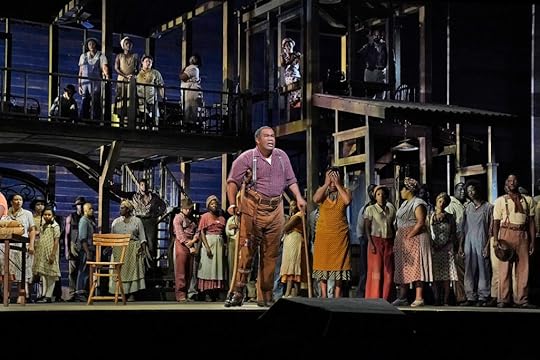
To read my review of the Met’s new “Porgy and Bess,” just posted online by “The American Scholar,” click here. It begins:
That the
Metropolitan Opera has opened its season with a fresh production of George
Gershwin’s Porgy and Bess is cause
for celebration.
The Met came late to black America when in 1955 it engaged Marian Anderson to sing Verdi—she was already 57 years old. It came late to Porgy when in 1985 it mounted an earlier production—half a century after the opera’s premiere. More than its predecessor, the Met’s vigorous new staging manages to vindicate a controversial cultural landmark and seal its stature as the highest creative achievement in American classical music. New York’s new Porgy is also cause for reflection and self-scrutiny. It must mean something that the most widely known American opera is a white composer’s version of black American life. It has no finished form. Its reputation remains unsettled. It feeds on the fraught racial sensitivities of the current moment.
When Porgy and Bess was introduced in 1935, a
prevalent response was: “What is it?” A second production, in 1941, reconceived
the opera as musical theater with dialogue. It subsequently became best known for
its songs. In the 1950s, the NAACP urged black artists to stay away from it.
More recently, a boldly revisionist version, with Audra McDonald as Bess,
aspired to add “dignity” to the main characters. At every stage in this saga,
the accompanying discourse has been charged and ill-informed.
Several
years ago, I found myself addressing
a graduate seminar on 20th-century opera. I asked the students what Porgy and Bess was about. A black
student volunteered: “It’s about black Americans.” Wrong, I said. Several
months ago, when the Met’s new production (shared with the English National
Opera and the Dutch National Opera) was given in London, a prominent local
critic called it a “period piece.” Wrong again, I say.
My review ends:
Edward Johnson [the Met’s General Manager in the thirties] found Porgy and Bess too black. James Baldwin considered it too white. Aaron Copland, Virgil Thomson, even Leonard Bernstein patronized Gershwin as something less than a “real composer.” Today that tide has turned. The modernist view of Gershwin the gifted dilettante is no longer heard. A burgeoning interest in the interwar fate of black classical music will surely promote new understandings of Gershwin as a necessary interloper between “classical” and “popular” genres severed by 20th-century aesthetic currents. If a whiff of opprobrium remains—if Porgy and Bess is resisted for “stereotypes” that do and do not inhabit Catfish Row—Gershwin’s opera will ever remain an inexhaustible American topic.
In retrospect, Porgy and Bess and the Metropolitan Opera have long needed one another. In 1935, Gershwin spurned Otto Kahn’s invitation to stage Porgy at the Met. In 1938 Johnson declared the Met uninterested in George Gershwin. In the seventies, Schuyler Chapin envisioned a Porgy and Bess conducted by Leonard Bernstein. In 1985, James Levine finally brought Porgy into the big house, but the production floundered. This time the marriage seems real.
RELATED LINKS:
I audition my favorite Porgy and Bess recordings: https://www.wwfm.org/post/postclassic...
My Times Literary Supplement review of the American Repertoire Theatre’s 2012 misproduction of Porgy and Bess: https://www.artsjournal.com/uq/2012/0...
September 21, 2019
Why Did American Classical Music “Stay White” — Take Two
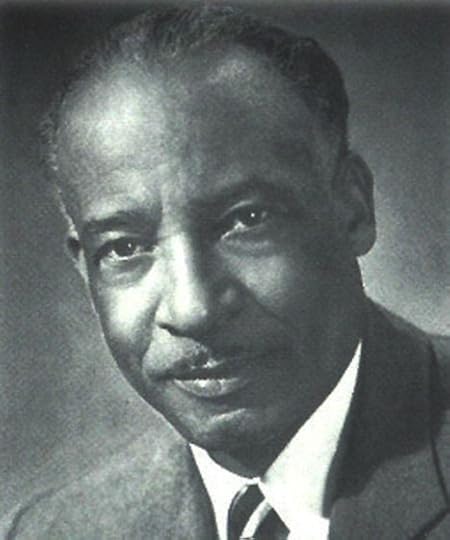 William Dawson
William DawsonPicking up on my American Scholar piece, Tom Huizenga of National Public Radio interviewed me about the fate of black classical music – and here is his interview.
Our conversation was
wide-reaching, and ultimately led to this exchange:
Huizenga: Near the
end of your essay, you write: “Might American classical music have
canonized, in parallel with jazz, an ‘American school’ privileging the black
vernacular?”
Horowitz: I don’t want to sound grandiose, but really it’s a question that all of us should be asking today — all of us who care about the fate of classical music in America. What we’re looking at right now, this extreme marginalization of classical music, is really the chickens coming home to roost. When I wrote Understanding Toscanini in 1987 and said, “This is a classical music culture built on sand, because it’s European sand,” most people beat me up for that and thought that I was out of my mind. But I was right. And we’re now suffering those consequences. We don’t have deep roots for our American classical music culture.
Here’s another exchange from the interview:
Huizenga: I love this quote from Dawson that you include in your essay. When he talks about his symphony, even before Stokowski premiered it, he says: “I’ve tried not to imitate Beethoven or Brahms, Franck or Ravel — but to be just myself, a Negro. To me the finest compliment that could be paid to my symphony when it has its premiere is that it unmistakably is not the work of a white man. I want the audience to say: ‘Only a Negro could have written that.’ ” But it seems Dvořák was suggesting that white composers should be writing symphonies that sound like Dawson’s. Are you also arguing for that?
Horowitz: Well, Morton Gould wrote a piece called Spirituals, and of course Gershwin wrote Porgy and Bess, contains some spirituals of his own. More generally, we’ve had innumerable examples of white composers drawing on the African American vernacular. The problem has been the quality of that work and its marginality. I’ll say explicitly I don’t believe you have to be black in order to write a great symphony or opera galvanized by great black vernacular music. That’s my personal opinion. I happen to think Porgy and Bess is a great opera. The guy who wrote it happened to be white. And you have this quote from Dawson that would seem to suggest otherwise. And it’s a compelling quote. It has actually been suggested that the Negro Folk Symphony is “black” not only for its sources but for its very style, which evokes improvisation. But that’s a dangerous topic to speculate about — what is “essentially” black or white. You’ve asked an uncomfortable question, right? And I’m giving you an uncomfortable answer.
And another:
Huizenga: Sometimes it takes an outsider [like Dvorak] to point out the true and valuable characteristics of a culture.
Horowitz: The Europeans tried. They actually would come
and lecture the Americans: They would say, “You don’t realize the
importance of your own African American music.” Ravel said that; Arthur
Honegger said that. And the
Americans — especially in the case of Olin Downes, the chief music critic of The New York Times —
said shut up, you’re wrong, don’t tell us what to do. If you read Olin Downes’ New York Times obituary for
George Gershwin, your skin will crawl. There is a feeling of contempt there,
that Gershwin was overrated and not the real thing.
Joseph Horowitz's Blog
- Joseph Horowitz's profile
- 17 followers



